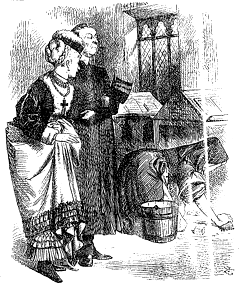

 his cartoon represents both issues of religion (Catholic Vs. Protestant) and how women were represented during the time. The priest points out to the "Fashionable Convert" how great and noble the nun is. She is a convent girl scrubbing the floor. The fashionable convent girl says that scrubbing the floor and doing manual labor is not at all what she expected, that she would rather stay in Belgravia.
his cartoon represents both issues of religion (Catholic Vs. Protestant) and how women were represented during the time. The priest points out to the "Fashionable Convert" how great and noble the nun is. She is a convent girl scrubbing the floor. The fashionable convent girl says that scrubbing the floor and doing manual labor is not at all what she expected, that she would rather stay in Belgravia. The nun on the floor is catholic, the fashionable convert was Protestant and according to the caption, will probably return to Protestantism.
The Mary Saurin case, the case of a disappointed nun going to court against her convent, is depicted in this cartoon. Mary Saurin had gone to a convent, yet sued the convent claiming that her fellow nuns were trying to drive her out.
She stated in her case that she was forced to do manual labor, such as scrub floors, and that she was stripped of her dignity. This cartoon says to all women that they should not join a convent unless they are ready to do manual labor and be stripped of their pride.
It also tackles the great religious debate: Catholic vs. Protestant. Catholicism, supposedly based on confession and sorcery (according to the Protestants), was despised by many Protestants whose major claim was that their relationship with god was defined by their work.
Here, there is a double meaning. The Catholic Nun is scrubbing the floors, and working hard, yet the "Fashionable Convert" retorts with a petty remark about her shoes. Not only does this symbolize a negative outlook on Convent life and Catholicism, it maintains the stereotype that women are petty and concerned with material objects such as shoes.
[Victorian initial "T" by Harlan Wallach ©copyright 1994.]